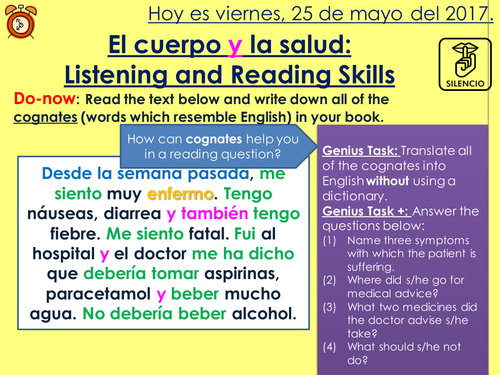


N.B. This lesson can easily be used in preparation for listening and reading assessment as it helps students develop both their exam skills and their capacity to consciously listen to TL.
- Ideal for learners of KS3 and lower KS4 Spanish, as the lesson includes plenty of scaffolding and step-by-step exploitation of audios.
- Total of 2 files in the package: a PowerPoint for the lesson which includes all slides (hidden with white backgrounds) to print for students; specifically-designed MP3 file.
- The content for the reading and listening files is based on 'Body and Health'. For support in teaching this topic, see other resources published by the same author.
- Lesson provides a balance of reading and listening activities and skills development so as to not overwhelm students with the development of just one skill.
- Activities and tips are based on the specifications for the new GCSE.
- Includes "think, pair, share" activities to foster an environment of deep thinking and student voice. Students take an active role in "thinking about their learning" (meta-cognition) and acknowledging their strengths and areas for improvement.
- Tasks include scaffolding to render activities as accessible as possible for students, as well as extension activities for more able students.
- Reading skills activities explore reading for gist and inferring positivity/negativity/neutrality from a text. Encourages students to use tools at their disposal such as recognising cognates.
- Transcript is provided for the listening activity (as well as the audio file). There is also a listening activity which involves providing students with a copy of the transcript which contains errors. Students have to listen to the audio and highlight/correct errors. This helps them to isolate different sounds and develop their ability to listen out for specific information in audio texts.
- Listening skills activities are based on academic research into:
(a) What students find most difficult about approaching an audio text
(b) Going beyond simply inferring information from audio texts and encouraging students to isolate individual words and phrases
(d) Encourages students to pay extra attention to letters and pronunciation
(e) Shows students a range of exam tips and how to listen for gist
(f) Shows students how to take advantage of all information and clues before they listen to the audio text
- Colour-coded texts according to word category to support students with dyslexia or lower literacy.
- Animated and visually engaging slides.
- Notes under slides to explain how teachers might like to deliver the lesson and also details the thinking behind each activity.
- Ideal for learners of KS3 and lower KS4 Spanish, as the lesson includes plenty of scaffolding and step-by-step exploitation of audios.
- Total of 2 files in the package: a PowerPoint for the lesson which includes all slides (hidden with white backgrounds) to print for students; specifically-designed MP3 file.
- The content for the reading and listening files is based on 'Body and Health'. For support in teaching this topic, see other resources published by the same author.
- Lesson provides a balance of reading and listening activities and skills development so as to not overwhelm students with the development of just one skill.
- Activities and tips are based on the specifications for the new GCSE.
- Includes "think, pair, share" activities to foster an environment of deep thinking and student voice. Students take an active role in "thinking about their learning" (meta-cognition) and acknowledging their strengths and areas for improvement.
- Tasks include scaffolding to render activities as accessible as possible for students, as well as extension activities for more able students.
- Reading skills activities explore reading for gist and inferring positivity/negativity/neutrality from a text. Encourages students to use tools at their disposal such as recognising cognates.
- Transcript is provided for the listening activity (as well as the audio file). There is also a listening activity which involves providing students with a copy of the transcript which contains errors. Students have to listen to the audio and highlight/correct errors. This helps them to isolate different sounds and develop their ability to listen out for specific information in audio texts.
- Listening skills activities are based on academic research into:
(a) What students find most difficult about approaching an audio text
(b) Going beyond simply inferring information from audio texts and encouraging students to isolate individual words and phrases
(d) Encourages students to pay extra attention to letters and pronunciation
(e) Shows students a range of exam tips and how to listen for gist
(f) Shows students how to take advantage of all information and clues before they listen to the audio text
- Colour-coded texts according to word category to support students with dyslexia or lower literacy.
- Animated and visually engaging slides.
- Notes under slides to explain how teachers might like to deliver the lesson and also details the thinking behind each activity.
Something went wrong, please try again later.
This resource hasn't been reviewed yet
To ensure quality for our reviews, only customers who have purchased this resource can review it
Report this resourceto let us know if it violates our terms and conditions.
Our customer service team will review your report and will be in touch.
£3.00